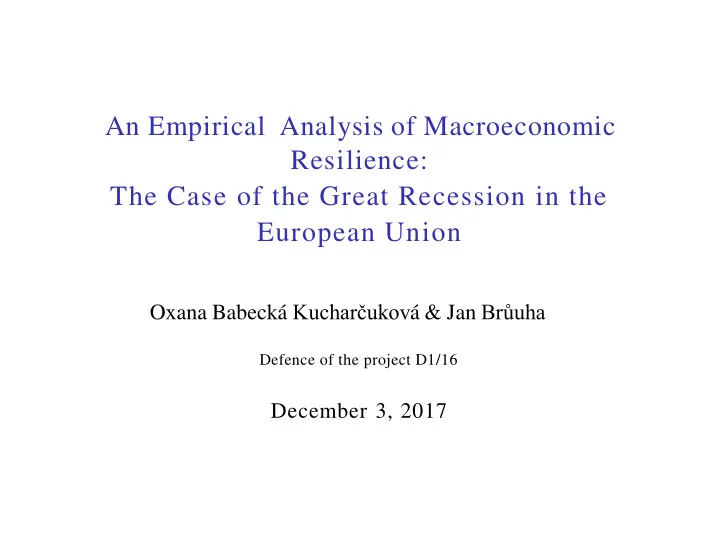

An Empirical Analysis of Macroeconomic Resilience: The Case of the Great Recession in the European Union Oxana Babecká Kucharčukov á & Jan Brůuha Defence of the project D1/16 December 3, 2017
Motivation: International Data
The distribution of the changes in unemployment rates across the E.U. (vis-a-vis 2007)
The distribution of the cumulative output growth across the E.U. (since 2007)
Various patterns across E.U. countries ► The initial drop in economic activity and in labour market slack differ across E.U. countries: ► its size may depend on trade and financial linkages. ► Nevertheless, the subsequent development is also far from uniform. ► In this research, we ask following questions: 1. Are there some common patterns across countries? 2. Are these patterns related to quality of institutions and to regulation? As there may be well defined patterns, mixture models seem to be an appropriate tool.
Econometric Model /3 We have applied this model to the EU 27 countries for: 1. cumulative real output growth: dY ct, ≡ log Y c,t − log Y c,2007 , 2. the change in the unemployment rate dU ct, ≡ U c,t − U c,2007 , relative to the pre-crisis year 2007. ► We then look at dynamics of hours worked, youth unemployment rate and labour share dynamics, to see whether these variables behave homogeneously across countries; ► as a sensitivity analysis (demanded by both referees), we also consider the dynamics of labour share and hours as additional variables considered by the model.
Estimation results /1 The estimation suggests four latent classes ( L = 4). Countries in the first latent class (DE, CZ, SK, MT, HU, PL): ► an initial decline in GDP between 2008 and 2010 of 4.5 % on average; ► a rise in the unemployment rate of 3 percentage points on average over the period; ► then, GDP growth resumed and unemployment subsequently started to fall; ► the unemployment rate in 2016 was lower than when it started in 2008 (NOT USED FOR CLASSIFICATION). ► wage growth followed the usual cyclical pattern.
Estimation results /2 The second class (BU, BE, DK, FR, CR, LU, NL, AT, RO, FI, SW): ► the GDP has reached or overcome by 2016 the pre-crisis level, ► unemployment was higher in 2016 compared to 2008, ► but less than by 2 p.p. ► Similarly to class I countries, the labour share exhibit a clear countercyclical pattern: ► in most countries of this latent class, the labour share was higher in 2016 than in 2008; ► the view that the post crisis period is a time of ‘subdued wage growth ’ is misleading .
Estimation results /3 The third class (EE, IE, LT, LV): ► a huge adverse shock in 2008 – 2010: a significant initial drop in GDP accompanied by a rapidly rising unemployment rate. ► the situation of these countries started to improve after 2010. ► This was reflected in a decline in unemployment, which, however, had still not fallen below the 2008 level by the start of 2016. ► Since 2010, labour productivity has been rising much faster than the average wage (which has been recording weakly positive or even negative growth); ► This may have helped to overcome the initial drop in labour demand.
Estimation results /4 The fourth (stressed) class (CY, IT, ES, PT, GR, SI): ► The labour markets did not start to significantly improve after 2011; ► the unemployment rate still higher at the start of 2016 than in 2008 (by more than 2 percentage points); ► relatively rapid wage growth, which significantly outpaced labour productivity growth on average.
Graphical representation: output dynamics
Graphical representation: unemployment dynamics
Graphical representation: dynamics of hours worked Note: not used for classification
Graphical representation: dynamics of labour share Note: not used for classification
Graphical representation: dynamics of youth unemployment
The Role of Institutions and Regulation /1
The Role of Institutions and Regulation /2
The Role of Institutions and Regulation – formal analysis We estimate the multinomial logit model of allocations of countries to classes: ► we use the elastic net approach to select relevant predictors. The following predictors are selected: ► pre-crisis Debt to GDP ratio (fiscal space), confirming the results by Romer and Romer, 2017; ► two WGI indices (Government Effectiveness and Political Stability); ► protection of temporary contracts. No role for generosity of U Benefits
Conclusions We have found that the EU countries can be classified into 4 latent classes based on their development during the crisis. 1. as a by-product of our analysis, we reject the view of subdued wage growth in recent years (in most cases, the labour share is now even higher than in 2007). Country classes differ by: ► fiscal space, ► the quality of regulation and political stability, and DO NOT differ by generosity of unemployment ► benefits. ► social net seem to not threaten the resilience of countries.
Recommend
More recommend